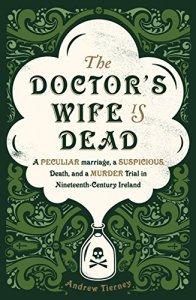 Historical True Crime
Historical True Crime4*s

On 1 May 1849 Ellen Langley dies in Nengh, County Tipperary the local women gather and stone the house she was living in. Meanwhile Doctor Langley tried to go about the business of removing Ellen’s body from the house; he did, she spent two days in the garden.
This is the account of one woman’s life, a fairly indistinct figure and her sad demise and one that serves as a commentary on how women were both viewed and treated at this time, with a focus on the laws in Ireland at the time. It is clear, for whatever reason, Ellen Langley had been cast aside by her husband and in 1849 that put her in a very precarious position indeed.
This was an interesting read although the explanation of the convoluted family relations slowed pace of the book with mini-biographies of countless kith and kin, fortunately there are some family trees at the start of the book to assist the reader.
Following these early explanations we then move onto the part of the book which was far more interesting, the inquest where Doctor Langley seems at pains to exonerate himself from the faintest whiff of suspicion of wrongdoing. As a Protestant man of social standing, a man who had attended inquests as an expert witness at previous murder trials (there was far more serious crime in County Tipperary at this time than I’d imagined) it is possible that the Doctor was just pre-empting any rumours, after all the fact that his marriage to Ellen had not been happy in the last few months was no secret. Or his efforts to appear innocent were those of a man who was trying to disguise his guilt?
One of the things that always strikes me about historical true crime is how much faster the wheels of justice tended to move in those days. Archaeologist Andrew Tierney has certainly dug deep to find the documents that detail the court proceedings and has resisted what surely must have been a big temptation to flesh Ellen out with more details than are actually available. As a result she remains a shadowy being which made me feel all the more compassionate for this woman who represents so many of her time.
You can’t have a historical account in Ireland without links the conflict between the Catholics and the Protestants and while this doesn’t overshadow the court case it is useful to have the context, if only to gain an understanding of social standing. Alongside that, Ellen died during the potato famine and the author paints a desperate picture of the effect this had on the local population, the contrast between the rich and the poor being readily apparent.
This is a worthy addition to my historical true crime collection and the arrogance and lack of compassion from some players in the court room, all men of course, women were not allowed at this time, was so blatant it defied belief at times, but there is a lot to keep the reader’s attention. And then we get to the ending, court case over, The Doctor’s Wife is Dead leaves us with a surprise discovery which left me shocked.
The Doctor’s Wife is Dead was my fourth read of my 20 Books of Summer Challenge 2017
First Published UK: 23 February 2017
Publisher: Penguin
No of Pages: 282
Genre: True Crime – Historical
Amazon UK
Amazon US


